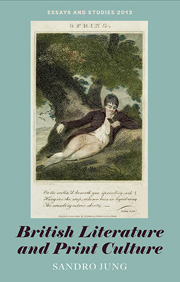Book contents
- Frontmatter
- Contents
- List of Illustrations
- Notes on Contributors
- Introduction
- Tracing a Genealogy of Oroonoko Editions
- The Pilgrim's Progress, Print Culture and the Dissenting Tradition
- Printing for the Author in the Long Eighteenth Century
- Robert Burn's Interleaved Scots Musical Museum: A Case-Study in the Vagaries of Editors and Owners
- Packaging, Design and Colour: From Fine-Printed to Small-Format Editions of Thomson's The Seasons, 1793–1802
- Print Illustrations and the Cultural Materialism of Scott's Waverley Novels
- Beyond Usefulness and Ephemerality: The Discursive Almanac, 1828–60
- The Last Years of a Victorian Monument: The Athenaeum after Maccoll
- Index
Printing for the Author in the Long Eighteenth Century
Published online by Cambridge University Press: 05 October 2013
- Frontmatter
- Contents
- List of Illustrations
- Notes on Contributors
- Introduction
- Tracing a Genealogy of Oroonoko Editions
- The Pilgrim's Progress, Print Culture and the Dissenting Tradition
- Printing for the Author in the Long Eighteenth Century
- Robert Burn's Interleaved Scots Musical Museum: A Case-Study in the Vagaries of Editors and Owners
- Packaging, Design and Colour: From Fine-Printed to Small-Format Editions of Thomson's The Seasons, 1793–1802
- Print Illustrations and the Cultural Materialism of Scott's Waverley Novels
- Beyond Usefulness and Ephemerality: The Discursive Almanac, 1828–60
- The Last Years of a Victorian Monument: The Athenaeum after Maccoll
- Index
Summary
Not so very long ago, critics and historians were maintaining with increasing confidence that the system of patronage which had operated time out of mind was superseded in the later seventeenth century by a new relationship between author and publisher. It is likely that the publication in 1989 of the English translation of Jürgen Habermas's hugely influential The Structural Transformation of the Public Sphere (first published in German in 1962) contributed to this new-found confidence. Certainly, the awesome assurance with which Habermas articulated the thesis that a ‘bourgeois public sphere’ first emerged in Britain ‘at the turn of the eighteenth century’ can scarcely be overstated:
The court aristocracy of the seventeenth century was not really a reading public. To be sure, it kept men of letters as it kept servants, but literary production based on patronage was more a matter of a kind of conspicuous consumption than of serious reading by an interested public. The latter arose only in the first decades of the eighteenth century, after the publisher replaced the patron as the author's commissioner and organized the commercial distribution of literary works.
For a number of reasons, however, the notion that the system of patronage was superseded between 1680 and 1750 has fallen under increasingly intense scrutiny in recent years. Attention has been drawn to certain inadequacies in the thesis that the rise of the professional writer was facilitated by the expiry of the Printing or Licensing Act in 1695 (13 & 14 Car 2, c. 33), followed by the passing of the first ‘Copyright’ Act in 1709 (8 Anne, c. 8). While it is true that, after 1695, writings were no longer subject to pre-printing censorship, it is important to stress that ‘it is nonsense to suppose that England suddenly acquired a free press in anything like the sense in which the concept was understood in the liberal democracies of the nineteenth and twentieth centuries’.
- Type
- Chapter
- Information
- British Literature and Print Culture , pp. 58 - 77Publisher: Boydell & BrewerPrint publication year: 2013



